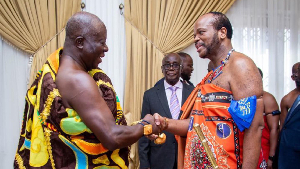 Asantehene Otumfuo Osei Tutu II (L) and King Mswati III (R) at the Manhyia Palace
Asantehene Otumfuo Osei Tutu II (L) and King Mswati III (R) at the Manhyia Palace
The King of Eswatini, King Mswati III, his wife, and his entourage were given a guided tour of the Manhyia Palace Museum in Kumasi as part of their visit to Ghana.
The tour, which took place on June 25, 2025, offered the Eswatini monarch an up-close look at the cultural and historical treasures of the Asante Kingdom.
In a video shared on social media, King Mswati III was seen walking through the museum, engaged as a museum guide, clad in traditional Kente cloth, explaining the meanings and origins behind various artefacts and symbols that tell the story of the Asante people.
One of the standout moments of the tour was an explanation of the talking drums, a communication tool in the Asante Kingdom.
“The talking drums, these drums, anytime they are beaten, they convey messages from the king to the people,” the guide said.
The monarch and his wife were also introduced to the Asantehemaa’s (Queenmother’s) palanquin, a ceremonial seat that shows the queen mother’s important role in the Asante Kingdom.
The guide explained the way the palanquin is carried and its meaning in Asante governance.
“The Asantehemaa sits on the chair and is carried by four strong men, two in front and two behind. At times, she is even carried on the head. If she is carried on the head, it tells so many things. It shows that the queen mother controls everything. The king seeks her advice on matters of governance. Our Asantehemaa is powerful when it comes to the kingdom of Asante,” he noted.
The tour also featured a framed coloured painting of the 14th Asante King, the first of its kind in Asanteman.
The guide explained the painting’s history, noting that it was done by a Hungarian woman who had visited Kumasi.
“This is the first coloured painting of the Asante Nation. This is the fourteenth King of Asante. It was painted by a Hungarian woman whose husband was in Kumasi. They were guests of the king. Seeing how beautifully he was dressed, and since there were no cameras at the time, she decided to paint him,” the guide explained.
Another key part of the tour included a breakdown of the Asante flag and its symbolism.
The guide emphasised that Asante was already a sovereign nation before Ghana’s independence and that the colours of the flag carried meaning.
“The yellow in the flag represents wealth, rich in gold. The black stands for the strength of the people. The green symbolises the virginity of the land. Together, we say the rich black man in the forest. That’s the meaning of our flag,” he stated.
The tour also showcased a wide range of historical items, including statues of former queen mothers, ceremonial swords, traditional stools, old television sets, and other relics that reflect the evolution of the Asante Kingdom.
King Mswati II and his wife toured the Manhyia Palace Museum. Learns the rich history of the Asante Kingdom 👑 pic.twitter.com/yaEtcKxCZg
— The Asante Nation (@Asante_nation) June 25, 2025
GhanaWeb Special: The gold market that fuels galamsey
How social engineering hacks your mind and your bank account
AK/BAI
